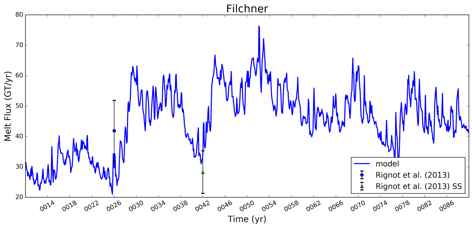v1 Cryosphere – Ocean
The cryosphere focus within E3SM addresses the scientific question
V1 SCIENTIFIC QUESTION:
What are the impacts of ocean-ice shelf interactions on melting of the Antarctic Ice Sheet, the global climate, and sea level rise?
With an eye towards eventually bounding Antarctica’s contribution to future sea-level rise over the next 50 years, Phase I simulations and analysis have focused on exploring the factors influencing submarine melt rates of Antarctic ice shelves and the impacts of related freshwater fluxes on the Antarctic-proximal, Southern Ocean circulation.
Ice shelves, which are critical in their role of impeding the flow of ice into the ocean and preventing unstable ice sheet retreat (Furst et al., 2016), are particularly vulnerable to rapid melting from below when relatively warm Circumpolar Deep Water (CDW) is able to enter the ocean-ice shelf cavity (Dinniman et al., 2016; Asay-Davis et al., 2017). In turn, the changes in ocean circulation responsible for the delivery of CDW occur via a complex chain of coupled ice sheet, sea ice, ocean, and atmosphere processes (Dutrieux et al., 2014).
However, despite the importance of ice shelves in preventing ice sheet retreat, scientists’ understanding of how oceans interact with ice sheets to cause sea level rise is limited. This is due to the lack of understanding of the coupled earth system dynamics that regulate the flow of the AIS into the Southern Ocean – a constraint stemming from the fact that relevant physical processes are not included in our modeling system.
Advancing Knowledge Through Demonstrating Model Validity

Depth-integrated transport from a global, coupled, 30-10 simulation with Antarctic ice shelf cavities (left). Zoom shows circulation beneath the Ronne-Filchner ice shelf in West Antarctica.
During Phase I, cryospheric science simulations have included coupled ocean and sea ice with data atmosphere and land forcing (Large and Yeager, 2008), as well as fully-coupled (active atmosphere and land) configurations at both low- and medium- resolution (i.e., 60-30km and 30-10km). Using new analytical capabilities specifically developed during Phase I for diagnosing and validating the relevant processes, E3SM has demonstrated the following:
- Simulated deep ocean properties around Antarctica are a closer match to observationally-constrained reanalysis products (Mazloff et al., 2010) when including ocean circulation in ice shelf cavities (Asay-Davis et al., 2018)
- Simulated sub-marine melt rates are closer to observations for many ice shelves when using higher spatial resolution (see figure a)) (Price et al., 2017).
- Simulated sub-marine melt rates are closer to observations for many ice shelves when fully coupled to the atmosphere than when using a data-atmosphere (Price et al., 2017).
- Simulated sub-marine melt rates from fully-coupled configurations demonstrate large interannual and decadal-scale variability (figure b)), likely due to coupled climate modes of variability (Price et al., 2017)

A 90-year submarine melt time series for the Filchner ice shelf (right) shows large interannual and decadal variability (Observationally-based estimates are from Rignot et al., 2013).
Ongoing work focuses on the analysis of a large ensemble of runs designed to identify and tune component-specific parameters in the ocean and sea ice models, in order to optimize sub-marine melt rates relative to observations (Asay-Davis et al., 2018). Phase II simulations will further build on these initial results through further validation during the historical period followed by exploration of how sub-marine melt rates will change under a range of future emissions scenarios.
CAMPAIGN UPDATES:


